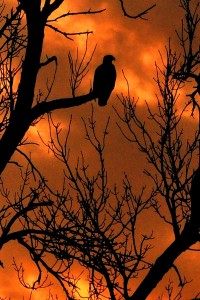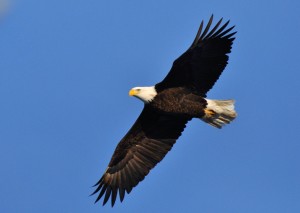Photography courtesy of Lowell Washburn, all rights reserved.
By the second week of December, there remained little question that winter had arrived. In northern Iowa, marshlands were frozen solid. At Clear Lake [where I live] more than 3,600 acres of open water had been reduced to two small air holes.
But although local weather conditions had turned frigid, the late season bird show was heating up as clouds of migratory waterfowl looked for a place to dunk their webs. Above those two tiny pockets of open water, a beehive of winged activity reigned supreme.
Waterfowl weren’t the only feathered travelers. Evicted from their northern homes, hundreds of bald eagles were also on the move. The scenario was simple. Open water attracts ducks and geese. Ducks and geese attract hungry eagles. Whenever those basic ingredients are combined, the stage is set for spectacular viewing.
There’s a common misconception that bald eagles only prey on the sick or injured. Not true. Like most predators, eagles are opportunists. Although not above scavenging, they will also catch, kill, and eat just about anything they can get their feet on. During periods of extreme weather, the menu can and does include perfectly healthy ten or eleven pound Canada geese.
Last weekend, I had the firsthand opportunity to watch the predator/prey drama played out at an air hole located along Clear Lake’s south shore. It was just past sunset, and noisy flocks of Canada geese were returning to the lake from nearby cornfields. Around 200 had already touched down and were either swimming or standing on the ice at the edge of the open water.
From a roost tree atop Woodford Island, a fully plumed adult bald eagle watched with interest. Launching an attack, the huge bird winged its way across a quarter mile of new ice. But the raptor’s approach did not go unnoticed. Scrambling off the ice and into the water, the geese had formed into a single compact ball by the time the eagle arrived. Undaunted, the winged predator immediately took a position directly above the flock. Hovering a mere three or four feet over the water, the huge bird assessed the situation. The only path to success was to grab a goose by the head or neck and then quickly drag it out of the water and onto the ice.
The task was formidable. Over a five-minute period, the hovering eagle made repeated dives at the flock. But there is safety, and in this case confusion, in numbers. The water flew high as dozens of geese would simultaneously disappear beneath the surface. With each repeated attempt, the eagle came up empty handed. The hunt was an energy consuming endeavor and the eagle’s stamina was amazing. But even a bird as magnificently powerful as this has its limit. Obviously exhausted, the open beaked panting raptor finally lit on the ice beside the geese. Following a couple minutes of rest, the eagle resumed the hunt which during the next several minutes was met with the same results. By now, it was nearly dark. More goose flocks were arriving but upon seeing the hovering eagle, continued across the ice. Finally giving in, the eagle headed back to its nighttime roost on the Island.
It takes a bald eagle at least five years to attain its distinctive, fully adult plumage. During that time, they learn what works and what doesn’t. The fact that an experienced adult was so persistent told me that the airhole tactic had paid off in the past. And although the eagle may have gone to bed hungry, tomorrow would be another day. The age-old contest would resume.
LW




 Susan Judkins Josten
Susan Judkins Josten Rudi Roeslein
Rudi Roeslein Elyssa McFarland
Elyssa McFarland Mark Langgin
Mark Langgin Adam Janke
Adam Janke Joe Henry
Joe Henry Sue Wilkinson
Sue Wilkinson Tom Cope
Tom Cope Kristin Ashenbrenner
Kristin Ashenbrenner Joe Wilkinson
Joe Wilkinson Dr. Tammy Mildenstein
Dr. Tammy Mildenstein Sean McMahon
Sean McMahon